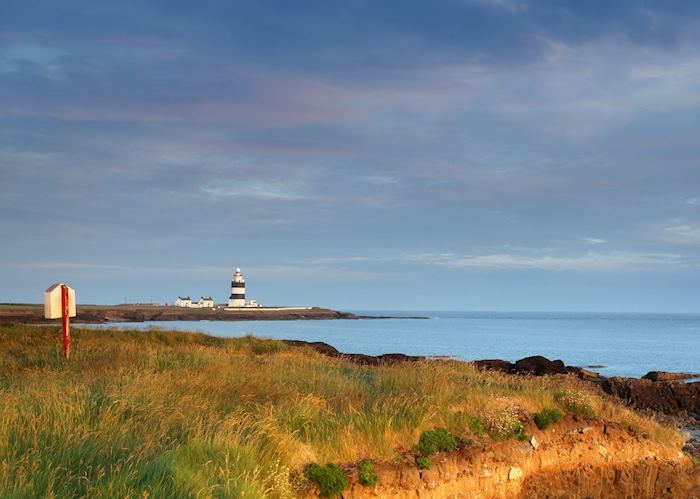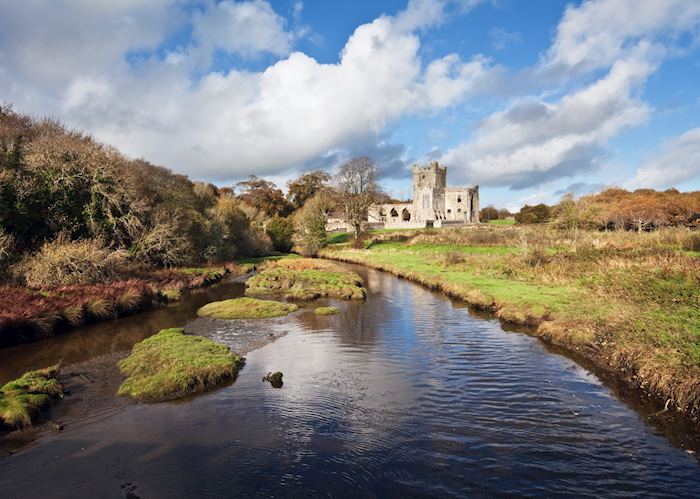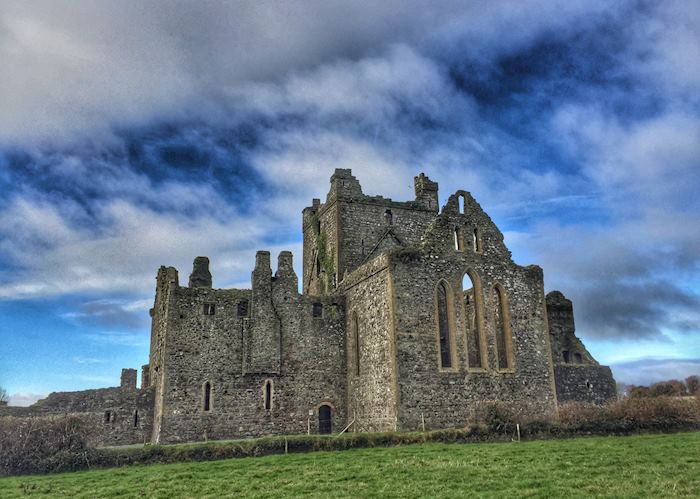Jump to:
The rich farmland, navigable rivers and proximity to significant trade routes meant that County Wexford enjoyed waves of great prosperity in the past. It also meant the region was liable to attack, with the Vikings first establishing a base here as early as 800 AD. Cistercian monasteries flourished in the Middle Ages, Confederate privateers attacked English fleets from their base in Wexford, and Oliver Cromwell arrived to quash them in 1649.
Today, the county is littered with remnants of its turbulent past. You’ll encounter ruined abbeys and castles standing alongside restored gardens, a replica famine ship and, near New Ross, the ancestral home of the most renowned Irish-American family, the Kennedys.
UK and Ireland specialist VicCounty Wexford is home to one of the only waterfront hotels in Ireland. I like Cliff House in Ardmore because it’s allows you to really experience the area’s seaside beauty and because it’s convenient to the drives of the Copper Coast.
Things to see and do in County Wexford
Kennedy homestead
Patrick Kennedy, the great grandfather of John Fitzgerald Kennedy, left Ireland during the Great Famine in the hope of forging a better life in the new world. His home near New Ross is now open to the public and houses a self-guided exhibition exploring five generations of the family, both in Ireland and the United States, and their influence on the world.
It begins with a look at the circumstances in Ireland that forced Patrick Kennedy to emigrate, and then traces his descendants as they dealt with tragedy, fame, scandal and loss over the following years. Displays of family memorabilia sit alongside photographs, archive footage, and a detailed display on JFK’s visit to the house in 1963.
Dunbrody Famine Ship
 It’s estimated that two million Irish people, a quarter of the population, emigrated in the mid-19th century because of the famine, many of them on what became known as ‘coffin ships’. Already weak from starvation, many didn’t survive the long journey in the cramped conditions aboard the ships. The Dunbrody Famine Ship, moored in New Ross, is a full-scale reproduction of one of these vessels.
It’s estimated that two million Irish people, a quarter of the population, emigrated in the mid-19th century because of the famine, many of them on what became known as ‘coffin ships’. Already weak from starvation, many didn’t survive the long journey in the cramped conditions aboard the ships. The Dunbrody Famine Ship, moored in New Ross, is a full-scale reproduction of one of these vessels.
As you tour the ship, a guide and costumed performers explain what life was like in Ireland at the time, the conditions aboard and how the immigrants were received on arrival in North America. After the tour, you can revisit sections of the ship at your leisure before finishing up in the Arrivals Hall, which looks at the life the newly arrived Irish could expect in their adopted land.
Dunbrody Abbey
A Cistercian monastery founded in the 13th century, Dunbrody Abbey flourished for several centuries. In the 15th century a tower was added to the large early-Gothic church, but the abbey was dissolved under Henry VIII, plundered, and then granted to the Etchingham family in 1545.
Part of the church was converted into a private residence, but a partial collapse in 1852 led to it being abandoned. Today, the nave still stands complete and the transepts, chapels and tower are well preserved. Nearby, you can visit Dunbrody Castle, a fortified house where there’s a small museum and a craft shop as well as a large yew hedge maze.
Tintern Abbey
 William Marshal, Earl of Pembroke, was caught in a storm off the Hook Peninsula in 1200 and vowed to build an abbey on the spot where he landed, should he safely make it to shore. He made good his promise after his deliverance to dry ground. The abbey was populated with monks from Tintern in Wales and became known as ‘Tintern de Voto’ (‘Tintern of the Vow’).
William Marshal, Earl of Pembroke, was caught in a storm off the Hook Peninsula in 1200 and vowed to build an abbey on the spot where he landed, should he safely make it to shore. He made good his promise after his deliverance to dry ground. The abbey was populated with monks from Tintern in Wales and became known as ‘Tintern de Voto’ (‘Tintern of the Vow’).
After the Dissolution of the Monasteries, the abbey became a private residence and was home to the Colclough (pronounced coke-lee) family from the 16th century right up to 1959. The nave was converted into a neo-Gothic residence in the 1790s and sits alongside the well-preserved chancel, tower, chapel and cloister. The family also built linen and flour mills, a walled garden and a battlement bridge over the river nearby.
Colclough Walled Garden
Follow a gravel path downhill from Tintern Abbey, cross the 16th-century stone bridge over the stream and continue through woodland to Colclough Walled Garden. It was created by the family in the early 19th century and has been restored to its 1838 layout with the ornamental east garden and the kitchen garden to the west. A wall whose bricks were made on-site using mud from the river estuary divides the two sections.
A river flows the length of the garden with five bridges crossing the water. Diamond-shaped flowerbeds host a riot of flowering species, there’s a restored Victorian-style vinery, and a choice of further walks into the woodland surrounding the gardens.
Best time to visit County Wexford
May to September is the best time to explore County Wexford with long days and warmer, drier weather.
who's been there
-
617-223-4521617-223-4757
- Make an inquiry
Places near County Wexford
- Waterford 28 miles away
- Kilkenny 40 miles away
- Dublin 71 miles away
- Cobh 85 miles away
- Cork 92 miles away
- Newgrange and the Boyne Valley 94 miles away
- Limerick 95 miles away
- Kinsale 98 miles away
- The Burren 117 miles away
- Galway 127 miles away
- Killarney 131 miles away
- Kenmare 137 miles away
- Inis Mór 145 miles away
- Enniskillen 148 miles away
- Sligo 158 miles away
- Belfast 158 miles away
- Dingle Peninsula 162 miles away
- Connemara 166 miles away
- Northern Ireland 168 miles away
- County Donegal 174 miles away
- Derry/Londonderry 188 miles away
- Giant’s Causeway 201 miles away
Photos of County Wexford
Accommodation choices for County Wexford
We've selected a range of accommodation options for when you visit County Wexford. Our choices usually come recommended for their character, facilities and service or location. Our specialists always aim to suggest properties that match your preferences.
-
![Dunbrody Country House Hotel, Arthurstown]()
Dunbrody Country House Hotel
County Wexford











